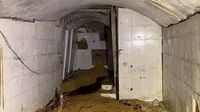On November 21, 2025, the volatile landscape of the Middle East was once again thrust into the global spotlight as violence surged across Gaza, East Jerusalem, and southern Lebanon. The events of the past 48 hours have laid bare the persistent instability plaguing the region, despite a ceasefire agreement that was supposed to bring hope and relief to millions. With each passing day, the human cost of this conflict continues to mount, leaving families shattered and communities in mourning.
According to reports from Al Jazeera and the Wafa news agency, two Palestinian teenagers were shot dead by Israeli forces in the Kafr Aqab neighborhood of occupied East Jerusalem on November 21. One of the victims, 16-year-old Sami Ibrahim Sami Mashayekh, was mourned by family and friends as his funeral procession wound through the streets—a stark reminder of the deep divisions and ongoing strife in the city. The same day, a displaced person was killed south of Gaza’s Khan Younis city, with Nasser Hospital confirming the fatality. These deaths were not isolated incidents but rather emblematic of a broader escalation that has swept the region.
In Gaza, the violence reached a harrowing peak. Medical officials at Nasser Hospital in Khan Younis reported receiving the bodies of 17 people, including five women and five children, after four Israeli airstrikes targeted tents sheltering displaced families. In Gaza City, two additional airstrikes killed 16 more people, among them seven children and three women. The total death toll from Israeli attacks in Gaza on November 20 alone reached 33, with many more injured. As reported by The Guardian, Gaza’s health ministry stated that over 300 people have been killed by Israeli strikes since the ceasefire came into effect last month, averaging more than seven deaths a day.
The Israeli military maintained that these airstrikes were in response to their soldiers coming under fire in Khan Younis on Wednesday, though no Israeli casualties were reported. Hamas, on the other hand, condemned the strikes as a “shocking massacre” and denied firing toward Israeli troops. The cycle of accusation and retaliation has become a grim routine, fueling a sense of hopelessness among Gaza’s residents. Lina Kuraz, a 33-year-old from the Tuffah neighborhood, expressed the pervasive anxiety gripping families: “My daughter kept asking me all night, ‘Will the war come back?’ Every time we try to regain hope, the shelling starts again. When will this nightmare end?”
Mohammed Hamdouna, who was displaced from northern Gaza to a tent in al-Mawasi, echoed this despair. “The intensity of the death toll has decreased, but martyrs and shelling happen every day. We are still living in tents. The cities are rubble; the crossings are still closed, and all the basic necessities of life are still lacking,” he told Agence France-Presse. The humanitarian crisis in Gaza remains acute, with infrastructure in ruins and access to aid severely restricted.
Qatar, a key mediator throughout the two-year war, strongly condemned the latest Israeli airstrikes, describing them as “brutal” and warning that they represented “a dangerous escalation that threatens to undermine the ceasefire agreement.” The fragile truce, brokered with international support, now hangs by a thread as each side accuses the other of violating its terms. The ceasefire’s stipulations included increasing the flow of humanitarian aid into Gaza and the return of hostages, both dead and alive, to Israel. Yet, the reality on the ground suggests little progress, with both Israeli military forces and Hamas holding significant leverage and territory.
The roots of the current conflict stretch back to October 2023, when Hamas-led militants launched a surprise attack into Israel, killing approximately 1,200 people—mostly civilians—and abducting 251 others. In the ensuing Israeli offensive and subsequent strikes, more than 69,000 Palestinians, the vast majority civilians, have lost their lives, according to Gaza’s health ministry. The devastation is so widespread that the bodies of thousands remain buried under the rubble.
Recent days have also seen violence spill beyond Gaza’s borders. On November 20, the Israeli Defense Forces (IDF) carried out a strike in southern Lebanon’s At Tiri area, killing a Hezbollah operative. The previous day, an Israeli airstrike killed 13 people in the Palestinian refugee camp of Ein el-Hilweh, marking the deadliest Israeli attack on Lebanon since the Israel-Hezbollah ceasefire a year ago. The Associated Press reports that these strikes were part of a broader campaign to neutralize threats and dismantle terrorist infrastructure in the region.
Meanwhile, the IDF exposed a sprawling underground tunnel network in Gaza, over 7 kilometers long, where Lieutenant Hadar Goldin was previously held. Video footage released by the IDF showed troops traversing the tunnel, which reportedly contained approximately 80 living quarters. This revelation underscores the complexity and depth of the military infrastructure that has fueled the conflict.
Israeli forces also conducted a large-scale operation overnight from November 20 to 21 in several villages in the Nablus region, aiming to locate weapons and arrest suspects involved in terrorist activities. During an arrest operation in Nablus city, armed Palestinians opened fire, wounding a reservist who was subsequently evacuated to a hospital. The incident highlights the ongoing volatility in the West Bank, where Israeli operations and Palestinian resistance continue to clash.
In the midst of these military developments, political maneuvering continues. On Monday, the UN Security Council endorsed a peace plan for Gaza, developed under the auspices of former U.S. President Donald Trump. The plan calls for the deployment of an international stabilization force and outlines a potential path to a sovereign Palestinian state. However, significant obstacles remain—not least of which are questions about how Hamas will be disarmed, who will provide the troops for the peacekeeping mission, and how full humanitarian aid can be delivered to Gaza without Israel lifting its blockade.
Further complicating the situation are allegations from the Israeli military that Hamas has diverted humanitarian funds from organizations such as Qawafil al Khair to support its military operations. Documents released by the IDF allege that these resources, intended for relief, were used to build training facilities and finance fighters, raising concerns about the integrity of aid distribution in the war-torn territory.
As the region grapples with these overlapping crises, the toll on ordinary people is immense. The images of funerals in East Jerusalem, the ruins of Gaza’s cities, and the battered refugee camps of Lebanon serve as poignant reminders of the ongoing tragedy. Political leaders and international actors continue to search for a solution, but for many on the ground, peace remains a distant hope.
The events of November 2025 underscore the enduring fragility of the Middle East’s security landscape. The cycle of violence, displacement, and loss shows no sign of abating, and the world watches anxiously as the search for a lasting resolution continues.




